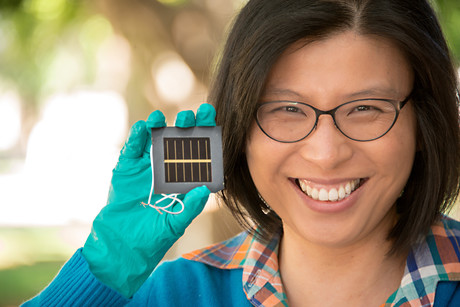New efficiency record for perovskite solar cells

Engineers at the University of New South Wales (UNSW) have been making strides in their research into perovskites, last week clinching the world’s highest efficiency rating with the largest perovskite solar cells to date.
The news was announced by Anita Ho-Baillie, a senior research fellow at the Australian Centre for Advanced Photovoltaics (ACAP), who said her team had achieved a 12.1% efficiency rating for a 16 cm2 perovskite solar cell — a cell which is at least 10 times bigger than the current certified high-efficiency perovskite solar cells on record. Her team has also achieved an 18% efficiency rating on a 1.2 cm2 single perovskite cell and an 11.5% for a 16 cm2 four-cell perovskite mini-module.
“Perovskites came out of nowhere in 2009, with an efficiency rating of 3.8%, and have since grown in leaps and bounds,” said Ho-Baillie. “These results place UNSW amongst the best groups in the world producing state-of-the-art, high-performance perovskite solar cells. And I think we can get to 24% within a year or so.”
To make perovskite solar cells, engineers grow crystals into perovskite — a structured compound where a hybrid organic-inorganic lead or tin halide-based material acts as the light-harvesting active layer. They first dissolve a selection of compounds in a liquid to make the ‘ink’, then deposit this on a specialised glass which can conduct electricity. When the ink dries, it leaves behind a thin film that crystallises on top of the glass when mild heat is applied, resulting in a thin layer of perovskite crystals. The tricky part is growing a thin film of perovskite crystals so the resulting solar cell absorbs a maximum amount of light.
Perovskites are attractive solar technology because the compound is cheap to produce and simple to manufacture, and can even be sprayed onto surfaces. As noted by Ho-Baillie, “The versatility of solution deposition of perovskite makes it possible to spray-coat, print or paint on solar cells. The diversity of chemical compositions also allows cells to be transparent or made of different colours.”
Although perovskites hold much promise for cost-effective solar energy, they are currently prone to fluctuating temperatures and moisture, making them last only a few months without protection. Nevertheless, there are many existing applications where even disposable low-cost, high-efficiency solar cells could be attractive, such as use in disaster response, device charging and lighting in electricity-poor regions of the world.
Ho-Baillie’s team has now joined the quest to try to extend perovskites’ durability. They are also looking to tackle issues important for commercialisation, like scaling to larger areas and improving cell durability.
Sustainable organic batteries for future energy storage
A rechargeable proton battery being developed by scientists at UNSW Sydney has the potential to...
CSIRO's solar venture secures $15 million funding
FPR Energy, a new venture from CSIRO, has secured $15 million in seed funding.
Aust partnership leads to solar-powered canola
Riverina Oils, a NSW canola oil producer, has partnered with Australian renewable energy retailer...







